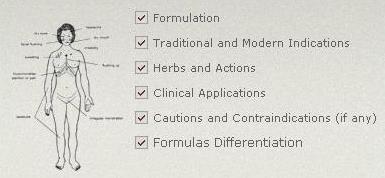Book Recommendation - Commonly Used Chinese Herb Formulas with Illustrations
Commonly Used Chinese Herb Formulas with Illustrations
The first version of the Commonly Used Chinese Herb Formulas with Illustrations was written by Dr. Hong-yen Hsu and Dr. Chau-shin Hsu, and published in 1980. During the late 70's and early 80's, there was a great upsurge of alternative health care associated with acupuncture and herbal treatment in U.S.A. Unfortunately at that time there were only a few books available in English that could introduce Chinese herbs and herbal formulas. Of these, the Commonly Used Chinese Herb Formulas with Illustrations was one of the most complete catalogs of Chinese herbal formulas available.

During the past twenty-five years the interest in natural health care has been dramatically increasing in the Western world and millions of people have had the experience of using of herbal remedies as part of their health care regime. Also there has been a vast amount of pharmacological research and clinical studies done regarding herbs and herbal formulas. And now there is a demand to refresh the knowledge of Chinese herbs and herbal formulas as well as to update information about the clinical applications and modern studies of herbology; especially in the light of the progressive integration of Eastern and Western medical knowledge.
Here we introduce some important parts of this book:
1. Details presentation of traditional information: Traditional information about each formula, such as the hierarchy of ingredients and the preparation of the formula, has been emphasized in each formula presentation to benefit the readers' understanding of the strategy behind the formulation. Another new category, commentary, discusses the characteristics of the formulation and also the therapeutic principles inherent to the formulation to further explore the traditional concept and use of the formula. The theories and concepts of traditional Chinese medicine associated with herbal formulation have also been quoted from the Treatise on Febrile Diseases (Shan Han Lun), Essentials from the Golden Chamber (Jin Gui Vao Lue), Yellow Emperor's Inner Classic (Huang Di Nei Jing), and other classic books to assist the readers' in gaining a deeper insight into the study of Chinese herbal formulation.
2. Scientific studies: New categories of information such as pharmacological research, clinical studies, and literature references have been added in this version. As important facets of scientific knowledge, they offer a high value in guiding the readers to practice more efficaciously.
3. Safety issues related to the use of natural products have recently been a focus of concern. Therefore we found it necessary to add more information in the three new sections labeled as precautions, contraindications, and toxicity to this new edition. The information presented in the precautions and contraindications section was gathered from clinical practice, while the toxicological data was obtained primarily from animal studies.
4. Herbs and Actions: One of the most difficult aspects of studying and practicing Chinese herbal formulation is to become familiar with all the ingredients and their actions within each formula. A chart format is presented in this book to illustrate and explain the action of the ingredients in detail and facilitate the learning process.

5. Formula differentiation table: In clinical practice, one of the major challenges is selecting a proper herbal formula for the patient as there are thousands of formulas available to choose from. To make a good herbal selection, it is important to be familiar with the discriminations among similar formulas. Therefore, a table format has been adapted in this version to ensure that the reader is able to easily compare the function, indication, and pathogenesis among similar formulas. In addition, the Key Points of Differentiation, which assists the practitioner with selecting a proper formula quickly, is also presented within the table.
6. Symptom illustration: more than 400 formulas including 391 classical formulas plus other associated formulas and 247 pictures are presented in the new version.
-
Up to now, there are more than 12 formula contents are available on our website, please click the link below to see details:
|
Pinellia and Gastrodia Combination (Ban Xia Bai Zhu Tian Ma Tang) | |||
|
Tang-kuei and Anemarrhena Combination (Dang Gui Nian Tong Tang) | |||
Interested in this book? Contact us for the book details!

